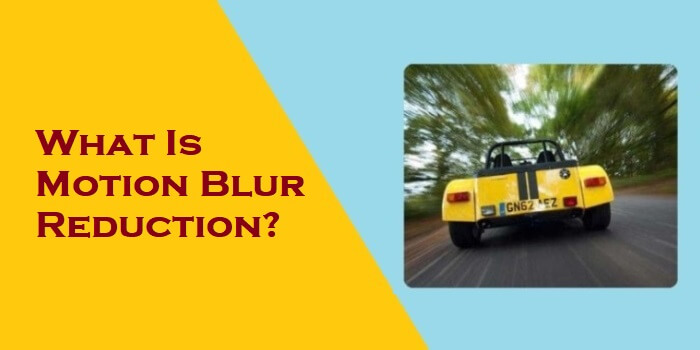A feature that has recently started appearing on some current gaming displays is called Motion Blur Reduction. Because of something called ‘test and-hold,’ outlines are shown once the picture regains its frame rate, making the picture blurry when displaying quick-moving images.
On current 120Hz+ gaming screens, Motion Blur Reduction for shows (ULMB, LightBoost, DyAc, and so forth) are necessary. Many G-SYNC displays include a “ULMB” setting, which can be switched on/off. These strategies use strobe lighting as a blur reduction technique.
What Is Motion Blur Reduction?
How Does Motion Blur Reduction Work?
MBR highlights can be an affliction, or you can encounter eye fatigue if you don’t utilize them. They are most often used to shrink the standing time of a section or speed up screen refresh rates. It is also possible to present a strobing effect by killing the backdrop illumination in the middle of recharging rather than leaving it.
Even though your eyes won’t notice these impacts, they will look at each pixel for less time since it is no longer shown for as long. You will feel as though you are utilizing an old CRT screen, as the technology and inherent strobing have similar effects. Consequently, the picture looks and feels smoother to the natural eye.
The Motion Blur Reduction highlights are not mandatory, they can be turned on and off, and to get the strobing effect, your GPU must be powerful enough to produce a high number of edges every second.
Motion Blur in Gaming:
In other words, a 60Hz screen will show 60 edges (‘pictures’) a second, whereas a 120Hz screen will show 120 advantages per second. It’s generally not a significant issue if you’re perusing or watching a film; it doesn’t usually make a difference. When you’re playing a relentless game, it can and will cause the picture to blur, potentially leading to dissatisfaction or more terrible execution.
If you were looking to buy the best monitors according to your budget tag, please check out our articles on this topic:-
More present-day gaming shows use advancements to limit eye following motion blur in addition to a higher refresh rate screen (as seen in the picture from blurbusters.com).
When Should You Use Motion Blur Reduction?
Your system, screen, PC game, drivers, picture settings, and picture quality are all factors in motion blur reduction. Although strobing the backdrop illumination makes a continuous interaction appear smoother, that certainly isn’t the case in all cases.
It is the first MBR innovation that can run VRR and strobe the backdrop illumination. However, on most screens, the technology is not tuned correctly, and you get a ton of strobe crosstalk.
Therefore, if you want the best motion clarity, you need to use MBR-only, and if you need to minimize time delay while maximizing info clarity, you need FreeSync/G-Sync.
For best results when using strobing while using background illumination, many gamers utilize V-Sync to synchronize their screens’ refresh rates with GPU frames. In order to minimize V-Sync’s additional information slack, set your frame rate 1FPS below your monitor’s highest refresh rate (143FPS for 144Hz monitors, for instance).
Drawbacks of Motion Blur Reduction
You may see the twofold photos or the strobe crosstalk in most screen shows; however, smaller-scale flaws are rare. As well as seeing the hues not as vibrant as expected and the display itself is dimmer than expected, some screens have better Motion Blur Reduction, and others don’t. Strobing has a better effect on screens with additional settings such as “Strobe Phase,” “Heartbeat Width,” or “Obligation Cycle.”
You can handle the issue of diminished picture splendor by physically altering the recurrence of lighting strobing. You can find that sweet equalization where motion clarity is improved without having to compromise on picture quality. There are probably a few screens that won’t have this issue, and the pictures should still look great even with the MBR on to ensure you’re reading our surveys before buying something.
The natural eye most likely won’t notice it all too often; however, you may feel cerebral pains after quite some time playing or using the PC if you are sensitive to it.
Different Types Of Blur Reduction
- LightBoost (NVIDIA)
- ULMB or Ultra Low Motion Blur (NVIDIA)
- PureXP or Pure Experience (ViewSonic)
- You or Dynamic Accuracy (BenQ ZOWIE)
- LMB or Extreme Low Motion Blur (ASUS)
- VRB or Visual Response Boost (Acer)
- Point Stabilizer (AORUS/Gigabyte Technology)
- MotionFlow Impulse (Sony)
- 1ms MPRT (LG)
Micro stutters and Blur Reduction
It’s important to use your PC’s design when modifying your blur reduction settings because many gamers find that after adjusting displays for transparency, they notice micro stutters on the screen. Because of this issue, we recommend that gamers own a good mouse, a good GPU and ensure that their edge rates work in tandem with the speed at which their showcase is regenerated.
Having a good VR headset will also help to decrease blur. Furthermore, quality VR headsets generally perform exceptionally well to reduce blur when gamers use synchronized outline rates. By synchronizing the edge rates with your display’s refresh rate, you should see the micro stutter disappear, and the clarity of your screen improve.
Taking care of Input Lag
Individual screens will use more input slack when a gamer uses blur reduction to alter the image to match their gaming needs. Another explanation gamers encounter when trying to fix screen clearness is how VSYNC ON lifts their input slack. In addition to using VSYNC ON, some gamers use an in-game casing rate top. By doing so, they can set their motion transparency and thereby eliminate the slack info issue.
One more method for gamers to reduce Monitor Motion Lag is to use scrubbing and framerates well beyond their refresh rate. This way, you’ll be able to mitigate micro stutters while still playing in VSYNC OFF mode.
Best of all about blur reduction is that the person in question can use their screen however they see fit. This way, you will be able to get the presentation you need out of your gaming screen.

